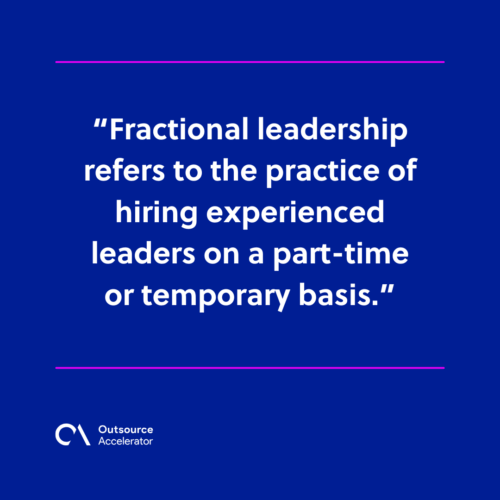How fractional leadership can drive innovation within organizations

Staying ahead of the curve often requires fresh approaches to leadership and innovation. And innovation isn’t just a buzzword but a necessity for survival and growth.
Yet, many organizations struggle to find the right leadership to spearhead new initiatives without overhauling their existing structure.
One approach that gets around this is fractional leadership. This strategy involves bringing in experienced leaders on a part-time or interim basis to drive specific actions or provide expertise.
What’s interesting is how these fractional leaders can play a pivotal role in igniting ingenuity within companies, making them a valuable asset.
In this article, we’ll see how fractional leadership can be a catalyst for innovation, creativity, and forward-thinking in organizational culture.
What is fractional leadership?
Fractional leadership refers to the practice of hiring experienced leaders on a part-time or temporary basis. These people, also known as fractional executives, fill leadership gaps, guide specific projects, and dispense strategic advice.
Fractional leaders work less than full-time, often dedicating their time and skills to multiple organizations simultaneously.

This approach is particularly valuable for businesses that need high-level skills but may not require or cannot afford a full-time executive. It also helps those undergoing periods of transition or crisis, providing a stable hand to help navigate complex situations. 7 types of fractional leadership roles
Fractional leadership roles encompass a range of executive positions, each providing specialized expertise on a part-time or temporary basis.
Here are some common types of fractional leadership roles:
1. Fractional CEO (Chief Executive Officer)
Fractional CEOs provide strategic direction and leadership to an organization. They often focus on high-level decision-making, business growth strategies, and overall company vision.
They may help startups establish their market presence or assist established companies during transitions or restructuring.
This role is ideal for companies needing experienced leadership without the cost and commitment of a full-time CEO. It may be during periods of change or when the business is in a growth phase.
2. Fractional CFO (Chief Financial Officer)
A fractional CFO provides part-time financial leadership and strategic guidance to organizations that may not require a full-time CFO.
Fractional CFOs can provide cost-effective solutions and assist with financial planning, forecasting, budgeting, and overall financial strategy.
3. Fractional CMO (Chief Marketing Officer)
This role involves part-time leadership in marketing strategy, branding, and market positioning. Fractional CMOs help organizations develop and execute marketing plans, improve lead generation, and enhance brand awareness.
4. Fractional CTO (Chief Technology Officer)
Fractional CTOs offer part-time guidance on technology strategy, infrastructure, and digital transformation. They help organizations leverage technology to achieve business objectives and stay competitive in the market.
5. Fractional COO (Chief Operating Officer)
This specialist provides part-time operational leadership, overseeing daily operations, process improvement, and efficiency. Fractional COOs help organizations streamline operations and enhance productivity.
6. Fractional CHRO (Chief Human Resources Officer)
A fractional CHRO offers part-time leadership in areas such as talent management, organizational development, and HR strategy.
This role assists in addressing HR challenges and aligning HR practices with business goals.
7. Fractional CSO(Chief Sales Officer)
Fractional CSOs’ role involve part-time leadership in sales strategy, revenue generation, and customer relationship management. They assist in developing sales processes, setting targets, and optimizing sales performance.
Strategies used by fractional leaders to drive innovation
Fractional leaders bring a fresh perspective and a wealth of experience to organizations, making them valuable assets in driving innovation.
Here are some key strategies they use to foster a culture of innovation and encourage creative thinking within companies:
Build strategic partnerships and alliances
Fractional leaders often leverage external partnerships to bring in new ideas, technologies, and expertise. These partnerships can accelerate innovation by providing access to resources and capabilities that the organization may lack.
They identify potential partners, such as startups, academic institutions, or other companies, and facilitate collaborations. These can lead to joint ventures, product co-development, or knowledge exchange initiatives.
Implement agile methodologies
Agile and lean methodologies are frameworks that emphasize iterative progress, customer feedback, and flexibility. Fractional leaders often use these approaches to drive innovation.
They break down projects into smaller, manageable phases, allowing for regular assessment and adjustment. This iterative process helps in quickly adapting to changes and continuously improving products or services.

Promote customer-centric innovation
Understanding customer needs and pain points is essential for developing innovative solutions. Fractional leaders emphasize customer-centric innovation, focusing on delivering exceptional value to customers.
They encourage the use of customer feedback, surveys, and market research to gain insights into customer preferences. They also implement design thinking workshops or customer journey mapping to develop solutions that meet real customer needs.
Encourage experimentation
Innovation often involves taking calculated risks and experimenting with new ideas. Fractional leaders foster an environment where employees feel safe to propose and test novel concepts without fear of failure.
These specialists promote a mindset that views failures as learning opportunities rather than setbacks. They may establish “innovation labs” or pilot projects where new ideas can be tested on a small scale before wider implementation.
Invest in talent
Fractional leaders recognize the importance of having skilled and motivated employees to drive innovation. They invest in talent development and upskilling to build a workforce capable of tackling new challenges.
They might introduce training programs, workshops, and mentoring opportunities to enhance employees’ skills.
By fostering a culture of continuous learning, fractional leadership empower employees to contribute to the company’s innovative efforts.







 Independent
Independent




